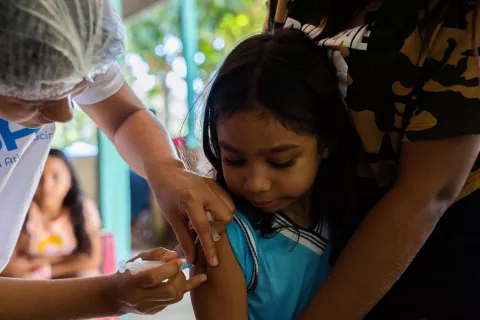Normal life washed away in Guatemala
Hurricanes in late 2020 were a double blow to a country already reeling from the COVID-19 pandemic.

CAMPUR, Guatemala — “My dad used to sell things at the farm supplies store over there,” Juana, 9, says as she points over the water from a boat, navigating the remains of her hometown. “This was a mill. There used to be a store over there. There was a house here.”
She hesitates, the sound of her voice replaced now with the hum of the boat’s engine and the chirping of a few birds in the distance.
“I can’t remember,” she begins again, gazing at the clouds reflected in the still waters. “I think that was our kitchen. Here was the church. There’s the gate. It makes me sad to see it.”

Just weeks before, Campur was a landlocked town in the north-central department of Alta Verapaz, surrounded by hills and lush forests. But the beautiful landscape has taken on an eerie quality since two powerful hurricanes – Eta and Iota – swept across Guatemala in November. Power lines, lampposts and the occasional roof sprout up from the tranquil waters that now cover most of the area.

Juana is one of more than 900,000 children in Guatemala affected by the two hurricanes, which struck in quick succession and left landslides and massive flooding across the region. Her family now lives with more than a dozen others at a temporary shelter established at a local primary school. By mid-December 2020, around 2,000 children across the country were estimated to be living in shelters.
“We used to play over there with my little brother,” Juana says, pointing. “I try not to remember because it just makes me sad.” Her brother follows her everywhere, repeating words and sentences like a friendly echo.

It’s December, and Juana’s whole family is living in a classroom. Like the other families living in the shelters, they received a hygiene kit – a bucket containing towels, soap, toothbrushes, disposable diapers, toothpaste, and other basic hygiene items – from UNICEF.
As she waits for the afternoon recreational activities at the shelter to start, Juana selects a toothbrush and runs to the bathroom. The playtime activities at shelters aim to help children cope with the trauma of having had their worlds turned upside down.
“Everything was dark. We had to go because the water was approaching. What if we had died under water? It was best to go,” Juana says. “I always look out for my brother.”
A sense of belonging
Maritza helps coordinate UNICEF’s emergency nutrition brigades, which have been responding to the disaster. She works in the shelters, looking for cases of acute malnutrition in children aged six months to five years old. When her team finds a suspected case, they weigh the child and share the measurements with the government to help guide public health policies. The team offers counseling, hygiene kits, and tips for people with conditions like hypertension and diabetes, both of which are common in the area. “We also offer advice on better ways of preparing food,” Maritza adds.

Maritza says that one of her team’s biggest strengths is that it has recruited staff from nearby so they can speak the local language.
“They’ve been here before. They’re trained. They’re from the area. So there’s a sense of cultural belonging that makes getting the message across easier.”
Return to Joy
Carlos Carrera, UNICEF’s representative in Guatemala, says the humanitarian needs of families and children displaced by the hurricanes are enormous and require a multi-pronged response. UNICEF has been working with the government, which has been developing a strategy for the opening of safe spaces—a challenge complicated by the ongoing risk of COVID-19. The strategy includes training volunteers on ‘Return to Joy’, a play-based approach culturally adapted to each community that uses child-to-child techniques to help children cope with upheaval.

UNICEF has been supporting this work with play boxes that contain hula hoops, memory games, puppets, balls, paper products, scissors and other materials for making posters. The recreational spaces also provide an opportunity to identify children who require additional support and counselling.
Such support is crucial in these moments of extreme vulnerability, bringing some sense of normalcy to children whose lives have been devastated.
“I used to play with my classmates at school when the bell rang,” Juana says. She points to a branch sticking out of the water. “My school used to be there, but you can’t see it anymore.”




